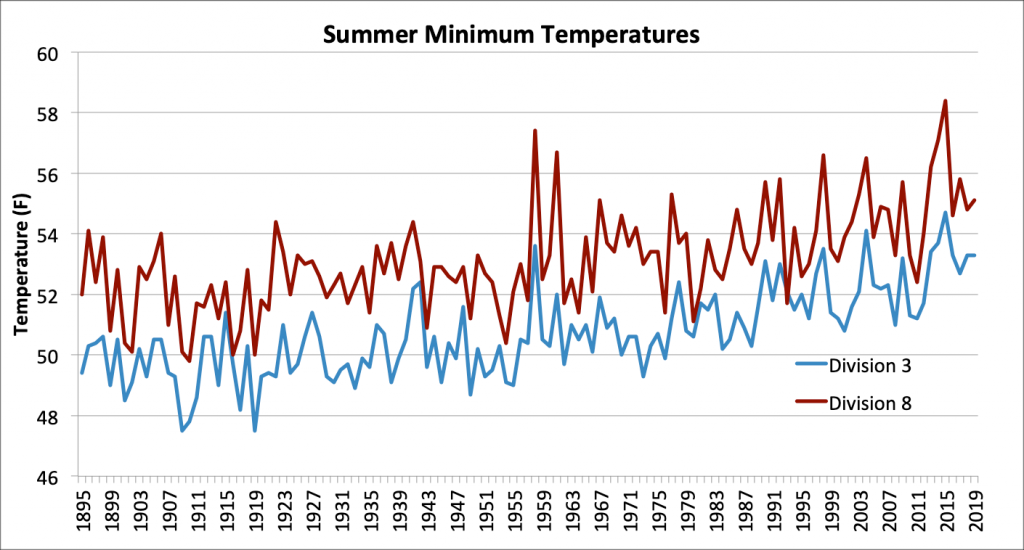The Warm Nights of Summer 2019
The summer of 2019 included very near-normal daytime temperatures for Washington state. The mean maximum temperature anomaly for the state as a whole for the months of June through August was 0.3°F (relative to 1981-2010). Minimum temperatures were a different story, with consistently warm nights, especially west of the Cascades. For example, the night of 19 July was the single instance between the last week of June and the last week of August during which the temperature dipped below normal at SeaTac Airport (KSEA). Other places were not as extreme, but for the most part, cool nights were rare. Keen observers also noticed that it seemed on the humid side, and not just during the occasional periods of rain we enjoyed during the past summer. The objective of the present piece is to examine the day-to-day variations in minimum temperature (hereafter, Tmin) and dewpoint (Td) during the past summer, with comparison of conditions on the west side with those on the east side of the Cascades. It represents a follow-up to the article in the August 2015 edition of this newsletter, which considered a similar topic for the state as a whole.


The results presented below use data from the PRISM 4 km gridded data set of daily values of Tmin and Td, available via the “Explorer” interactive tool (http://www.prism.oregonstate.edu/explorer/). The values of Tmin and Td are based on station data and a method termed climatologically-aided interpolation (CAI). We focus on two lowland and relatively rural locations, one near Olympia representing the Puget Sound Climate Division (#3) and one near Ritzville representing Central Basin Climate Division (#8). Their time series are shown in Figure 1.
A strong correspondence is evident between Tmin and daily mean Td at Olympia. At that location, the Tmin was actually often less than Td, which may seem odd at first blush in that the atmosphere simply never becomes supersaturated by anything more than at most a very tiny extent. Olympia Airport is known to be one of the cooler locations in the Puget Sound during the late night and early morning hours. What often happens is that the formation of dew (or frost in the winter) represents a sink for atmospheric water vapor near the surface, resulting in a temporary lowering of the Td, allowing surface air temperatures to also drop. While the Td is not strictly a lower limit, it can serve as essentially a floor for the Tmin, which seems to be also the case at other locations in the vicinity of Puget Sound. Note that there also was a positive relationship between Tmin and Td at Ritzville during the summer of 2019, but it was not quite as strong. At that location Tmin rarely dropped below the daily mean Td; our interpretation is that the humidity is not as strong of a determinant because the relative humidity on the east side tends to be less than on the west side. We tested this conjecture using summer Tmin and Td data for the years of 1948-2018, averaging PRISM data for four locations each in Climate Division 3 and 8 to estimate values for the summers as a whole in each region. The linear correlation coefficient between summer mean values of Tmin and Td for the Puget Sound region is about 0.73, and for the Central Basin is about 0.47, implying that Td “explains” more than twice the amount of variance in the year to year variations of Tmin in the former as compared with the latter. To be precise, we are not trying to make any strict claims concerning attribution but rather just that there is a stronger association between Tmin and Td on the west side.

While on the subject of Tmin in summer, we felt it worthwhile to update some of the information that was presented in the August 2015 edition of this newsletter. Figure 2 illustrates the summer (June-August) mean values of Tmin for WA Climate Divisions 3 and 8 for the years of 1895 through 2019, from NOAA’s “Climate at a Glance” website. The increases in this variable for both regions of WA state are obvious, even striking, in their consistency compared to most climate time series. The bottom line is that if your residence lacks air conditioning, you may be well-advised to at least get a decent fan before next summer rolls around…while our summer nights are pleasantly cool compared to much of the rest of the country they are getting warmer and slightly stickier.
